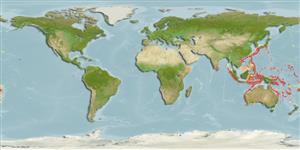>
Perciformes/Scorpaenoidei (Scorpionfishes) >
Peristediidae (Armored searobins or armored gurnards)
Etymology: Satyrichthys: Latin, satyrus = a god or demon, partly human and partly bestial, companion of Bacchus + Greek, ichthys = fish (Ref. 45335).
More on author: Bleeker.
Environment: milieu / climate zone / depth range / distribution range
Ecologie
marien bathydemersaal; diepte 192 - 420 m (Ref. 93228). Deep-water
East Indo-West Pacific: Japan, East China Sea, Indonesia and Australia.
Grootte / Gewicht / Leeftijd
Maturity: Lm ? range ? - ? cm
Max length : 48.0 cm SL mannelijk / geslacht onbekend; (Ref. 93228)
Levenscyclus en paargedrag
Maturities | Voortplanting | Spawnings | Egg(s) | Fecundities | Larven
Kawai, T., 2013. Revision of the peristediid genus Satyrichthys (Actinopterygii: Teleostei) with the description of a new species, S. milleri sp. nov. Zootaxa 3635(4):419-438. (Ref. 93228)
Status op de Rode Lijst van het IUCN (Ref. 130435)
Gevaar voor de mens
Harmless
Gebruik door de mens
Tools
Speciale rapporten
Download XML
Internetbronnen
Estimates based on models
Preferred temperature (Ref.
123201): 1.8 - 18.7, mean 13 °C (based on 134 cells).
Fylogenetische diversiteitsindex (Ref.
82804): PD
50 = 0.5078 [Uniqueness, from 0.5 = low to 2.0 = high].
Bayesian length-weight: a=0.00646 (0.00304 - 0.01372), b=3.08 (2.90 - 3.26), in cm total length, based on LWR estimates for this (Sub)family-body shape (Ref.
93245).
Trofisch niveau (Ref.
69278): 3.6 ±0.3 se; based on size and trophs of closest relatives
Weerstandsvermogen (Ref.
120179): laag, minimale populatieverdubbelingstijd 4,5-14 jaar (Preliminary K or Fecundity.).
Fishing Vulnerability (Ref.
59153): Moderate vulnerability (43 of 100).
